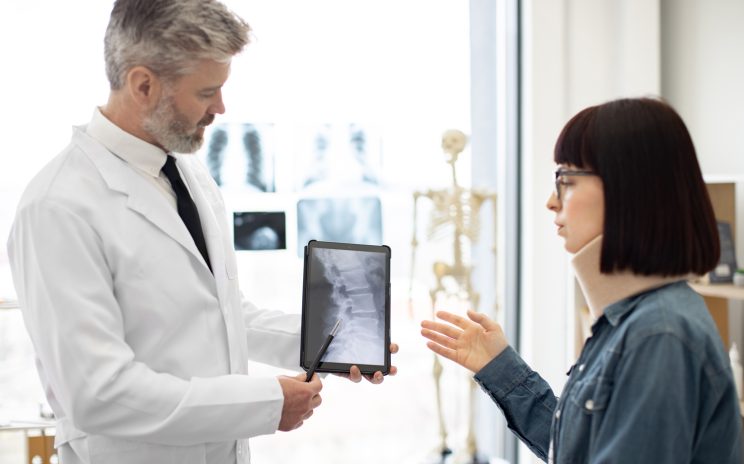Need a Doctor?

Your Trusted Source for Comprehensive Injury Care
At Injury Helpline, we specialize in providing comprehensive care for a wide range of injuries. Our dedicated team of doctors is here to help you heal and get back on your feet. Contact us today for personalized injury treatment and compassionate care.
Vehicle Injuries:
Whiplash
Whiplash is a common injury resulting from rear-end collisions, causing neck strain due to sudden backward and forward movement of the head. To reduce the risk of whiplash, ensure your vehicle’s headrest is properly adjusted to support your head and neck in the event of a rear-end collision.
Treatment for whiplash often involves a combination of rest, ice, pain relievers, and gentle exercises to improve neck mobility. In severe cases, physical therapy or chiropractic care may be recommended to alleviate symptoms and promote healing.
Traumatic Brain Injury (TBI)
Vehicle accidents can also result in traumatic brain injuries, ranging from mild concussions to severe head trauma. Always wear a seatbelt and ensure passengers are properly restrained to minimize the risk of head injuries. Additionally, avoid distractions while driving, such as texting or using electronic devices.
Treatment for TBI varies depending on the severity of the injury. Mild concussions may require rest and monitoring for symptoms, while more severe cases may necessitate hospitalization, medication, rehabilitation therapy, or even surgery in extreme cases.
Broken Bones
Impact during a vehicle collision can lead to fractures or broken bones, particularly in the limbs or ribs. To prevent fractures, ensure all passengers are securely buckled up, and children are seated in appropriate car seats or booster seats according to their age and size.
Treatment for fractures or broken bones typically involves immobilization with casts or splints, pain management, and physical therapy to regain strength and mobility. In some cases, surgery may be required to realign and stabilize the fracture.
Slip and Fall:
Wet or Uneven Surfaces
Slip and fall accidents often occur due to wet or uneven surfaces, such as slippery floors or cracked sidewalks. To reduce the risk of falls, promptly clean up spills, install non-slip mats in high-risk areas, and repair any uneven or damaged walking surfaces.
Treatment for injuries sustained from slip and fall incidents may include rest, ice, compression, and elevation (R.I.C.E.), along with pain relievers as needed. In cases of severe injuries, such as fractures or head trauma, medical intervention and rehabilitation therapy may be necessary.
Poor Lighting
Inadequate lighting can contribute to slip and fall accidents, especially in dimly lit areas or stairwells. Ensure proper lighting is installed both indoors and outdoors to improve visibility and reduce the risk of falls, particularly in low-traffic areas.
Treatment for injuries resulting from poor lighting conditions often involves addressing the underlying cause, such as installing adequate lighting fixtures or improving visibility in dimly lit areas. For individuals who have sustained injuries, prompt medical evaluation and appropriate treatment are essential for recovery.
Cluttered Walkways
Keep walkways clear of obstacles and clutter to prevent tripping hazards. Encourage employees and visitors to promptly report any potential hazards, such as loose cables or obstructed pathways, for prompt resolution.
Treatment for injuries caused by cluttered walkways may include first aid measures for minor injuries, such as cuts or bruises, and seeking medical attention for more serious injuries like sprains or fractures. Preventive measures, such as maintaining clear walkways and addressing clutter promptly, can help reduce the risk of future incidents.
Workspace:
Musculoskeletal Disorders (MSDs)
MSDs are common workplace injuries resulting from repetitive motions, poor ergonomics, or heavy lifting. To prevent MSDs, provide ergonomic training for employees, implement proper lifting techniques, and offer ergonomic workstations with adjustable chairs and desks.
Treatment for MSDs often involves a combination of rest, physical therapy, ergonomic modifications, and pain management techniques. In severe cases, medications or surgical interventions may be considered to alleviate symptoms and improve function.
Slips, Trips, and Falls
Workplace environments with slippery floors, cluttered walkways, or inadequate lighting can increase the risk of slips, trips, and falls. Conduct regular safety inspections, maintain clean and organized workspaces, and address any potential hazards promptly to prevent accidents.
Treatment for injuries resulting from slips, trips, and falls may include first aid measures for minor injuries and medical evaluation for more severe injuries. Physical therapy or rehabilitation therapy may be recommended to aid in recovery and prevent long-term complications.
Strains and Sprains
Overexertion from lifting heavy objects or performing repetitive tasks can lead to strains and sprains. Encourage employees to take regular breaks, rotate tasks to minimize repetitive strain, and provide mechanical aids or lifting equipment for heavy lifting tasks.
Treatment for strains and sprains typically involves rest, ice, compression, and elevation (R.I.C.E.), along with over-the-counter pain relievers as needed. Physical therapy or occupational therapy may be prescribed to improve strength, flexibility, and function.
Search
Any Question?
“By staying vigilant and implementing preventive measures, we can create safer environments and reduce the risk of injuries in various settings”.
Remember
If you or a loved one has been injured due to a vehicle accident, slip and fall incident, or workplace hazard, don't hesitate to contact Injury Helpline for expert guidance and personalized care. Your safety and well-being are our top priorities.